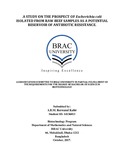| dc.contributor.advisor | Tabrejee, Samira | |
| dc.contributor.advisor | Islam, Jubaida Marufee | |
| dc.contributor.author | Kabir, A.B.M. Rezwanul | |
| dc.date.accessioned | 2017-11-13T08:29:58Z | |
| dc.date.available | 2017-11-13T08:29:58Z | |
| dc.date.copyright | 2017 | |
| dc.date.issued | 2017-10 | |
| dc.identifier.other | ID 14136013 | |
| dc.identifier.uri | http://hdl.handle.net/10361/8506 | |
| dc.description | Cataloged from PDF version of thesis report. | |
| dc.description | Includes bibliographical references (48-51). | |
| dc.description | This thesis report is submitted in partial fulfillment of the requirement for the degree of B.Sc in Biotechnology, 2017. | |
| dc.description.abstract | Abstract
With the consumption of beef reaching new heights each year all over the world, the prospect of E. coli isolated from raw beef samples as a potential reservoir of antibiotic resistance was investigated. A total of 17 E. coli isolates were obtained from raw beef samples collected from Mirpur area in Dhaka city. Antibiotic susceptibility test of these isolates showed that all the isolates were resistant to Penicillin and Oxacillin. The isolates also exhibited resistance to Cephalexin (94%), Erythromycin (71%), Streptomycin (24%), Tetracycline (18%), Amoxicillin (12%), Kanamycin (12%), Ampicillin (12%) and Levofloxacin (5.9%). The antibiotic susceptibility test also revealed that two isolates, S6 and S8, were resistant to 15 out of 20 (75%) antibiotics that they were tested upon. Analysis of the plasmid profiles of the isolates showed that the isolates harbored different number of plasmid that ranged from 1 to 3. The size of plasmids also varied, with plasmids as small as 2.0MDa to as big as 65MDa were observed. The two highest multi-drug resistant isolates, S6 and S8, were seen to share a common plasmid of 2.0MDa that might account for the high level of resistance. This 2.0MDa plasmid was seen have resemblance in size with the plasmids pOSAK1 and p4821 which were found to share homology with the core region of the antibiotic resistance plasmid NTP16 of Salmonella typhimurium strains. One of the two highest multi-drug resistant isolate, S6, was seen to harbor a 65MDa plasmid that shared resemblance in size to the plasmid pO157 which is characteristic to the Shiga toxin-producing E. coli O157:H7. Analysis of the plasmid profiles and antibiotic susceptibility tests revealed that a correlation between the plasmids and antibiotic resistance can be established. | en_US |
| dc.description.statementofresponsibility | A.B.M. Rezwanul Kabir | |
| dc.format.extent | 58 pages | |
| dc.language.iso | en | en_US |
| dc.publisher | BRAC University | en_US |
| dc.rights | BRAC University thesis are protected by copyright. They may be viewed from this source for any purpose, but reproduction or distribution in any format is prohibited without written permission. | |
| dc.subject | Escherichia coli | en_US |
| dc.subject | Antibiotic resistance | |
| dc.title | A study on the prospect of Escherichia coli isolated from row beef samples as a potential reservoir antibiotic resistance. | en_US |
| dc.type | Thesis | en_US |
| dc.contributor.department | Department of Mathematics and Natural Sciences, BRAC University | |
| dc.description.degree | B. Biotechnology | |

